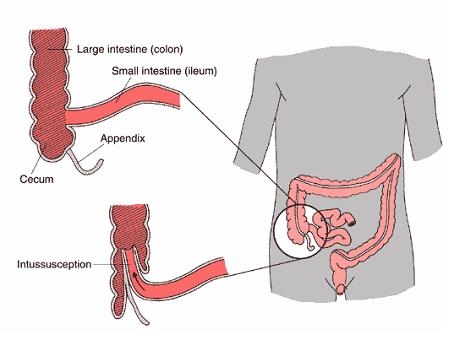Intussusception Symptoms, Causes, Diagnosis and Treatment

What Is Intussusception?
It is a critical disorder wherein part of your intestine tends to slide into the adjacent part of your intestine, like a telescope. Often, this obstructs fluid or food from passing by.
The disorder can discontinue the supply of blood to the affected intestine’s part. It can also cause perforation, death and infection of your bowel tissue. Intestinal obstruction is commonly caused by intussusceptions in children less than three years of age.
The disorder is uncommon in adults. Though majority instances of intussusception in adult are the consequent of an underlying health condition for example tumor. On the contrary, the reason of majority instances of child intussusceptions is unidentified.
In adults, doctors suggest surgery as a reliable option for treating the disorder, whereas intestines can be pressed back into its actual position through an X-ray procedure in children.
What Are The Symptoms Of Intussusceptions?
- In children: abdominal pain, lethargy, lump in abdomen, vomiting and stool mixed with mucus and blood are few common symptoms of intussusception in children. Rarely, these symptoms may accompany constipation, fever or diarrhea.
- In adults: Since intussusception rarely occurs in adults, and its signs are usually nonspecific, thus, diagnosing it can be a difficult task. However; abdominal pain followed by diarrhea, vomiting and nausea can be the prominent symptoms in adults with intussusception. A major percentage of individuals notice no symptoms.
What Causes Intussusception?
In majority instances of child intussusceptions, the cause remains a mystery. Few believe the role of virus in its occurrence while in rare cases, a lead point- Meckel’s diverticulum is identified for sourcing intussusception.
In adults, the disorder is caused due to the consequent of a health condition, for example adhesions, a tumor, hematoma, surgical scars in the colon or small intestine or inflammation (for example due to Crohn’s disease.
What Are The Risk Factors Of Intussusception?
Certain factors identified for increasing the risk of intussusceptions are:
- The disorder is more common in children as compared to adults.
- Boys are more likely to experience intussusceptions than girls.
- Congenital intestinal malrotation also increases the chances of intussusception.
- Individuals with a history of intussusceptions in the past are more prone to develop it again.
What Are The Complications Of Intussception?
Complications associated with the disorder include:
- Perforation.
- Peritonitis.
How Is Intussusception Diagnosed?
The doctor will need complete details regarding the symptoms of the patient. In order to ascertain the cause that is leading the symptoms, the doctor can suggest the following:
- Abdominal imaging or ultrasound.
- Barium or air enema.
How Is Intussusceptions Treated?
In order to treat intussusceptions, the doctor can suggest the either:
- Air or barium enema: interestingly, this is a treatment and a diagnostic procedure as well. In most cases, if an enema treats the problem, no additional treatment is then needed. It works effectively particularly in children.
- Surgery: in case of a torn intestine, and an enema has failed to treat intussusception, the doctor can suggest surgery.
By : Natural Health News




